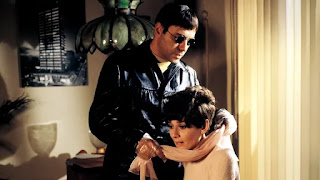(1962)
Overall: WOOF
As one could suspect, writer/director/producer/editor/hack Jerry Warren's take on jungle adventure is a snore-inducing one. Shot at Griffith Park, Los Angeles which stands in for the Devil's Island in French Guiana adequately enough, Terror of the Blood Hunters features a small handful of people trying to escape the deadly location, except that we only occasionally get the sense that it is dangerous. Prison guards sometimes are shown tracking them down or at least talking about tracking them down, stock footaged wild animals run about, and Warren filmed some scenes of scantily clad ladies gyrating to jungle drums to convey that there is a deadly tribe of locals who also pose a threat. The incessant library-cued musical score is even more arbitrarily used and off-putting than usual, incorrectly signifying menace when there is nothing of the sort transpiring on screen. Warren's regular leading man Robert Clarke and the rest of the poor cast try to save face with what was hopefully a quick shooting schedule and an agreeable paycheck, but there is no style or even unintentional humor to be found here.
(1965)
Dir - Carlos Schlieper/Carlos Hugo Christensen/Jerry Warren
Overall: WOOF
Another slap-dash re-edit from Jerry Warren, Curse of the Stone Hand takes footage from two 1940's, non-horror Chilean films, Carlos Schlieper's La casa está vacía and Carlos Hugo Christensen's La dama de la muerte, respectively. Always one to give John Carradine some work, Warren shoehorns him into the newly-shot segments and then has Bruno Ve Sota narrate a plot that becomes increasingly impossible to follow. This is understandable since taking two unrelated movies that were decades old and then adding even more unrelated stuff to them while dubbing everyone's dialog when their faces are not on the screen is bound to not hold up under a microscope. On the plus side since Warren only shot a small percentage of the footage himself, it at least looks like a real movie as both Christensen and Schlieper were actually competent filmmakers who knew how cinematography, scenery, and mood works. Still, it is always embarrassing when the best thing that you can say about somebody's movie is that the only acceptable parts are the ones that they had nothing to do with.
HOUSE OF BLACK DEATH
(1965)
Dir - Harold Daniels/Jerry Warren/Reginald LeBorg
Overall: MEH
A slapdash mess comprised of footage shot by three different directors, House of Black Death, (Blood of the Man Devil), is only a minor curiosity for Golden Era horror fans who wish to see an aged Lon Chaney Jr. and John Carradine playing rival Satanic cult leaders who never share any scenes together. Harold Daniels and Reginald LeBorg in a minimal capacity initially shot the movie before producers hired Jerry Warren to throw some more talky nonsense into the proceedings, which mucks things up as much as would be expected. Warren brought in his frequent on-screen collaborator Katherine Victor, though her role is no more prominent than any of the other forgettable faces who are merely collecting a paycheck. While Chaney dons small devil horns underneath his robe and grins in a drunken stupor as glamour model Sabrina belly dances many times over, Carradine is largely absent or bedridden until he finally gets to spout some unholy gibberish at the end. A guy does turn into a werewolf kind of while rolling around on the floor which is minimally hilarious, but as far as everything else that happens, it is not worth paying attention to and rendered nearly incomprehensible by the sloppy and low-budget production.
(1965)
Dir - Harold Daniels/Jerry Warren/Reginald LeBorg
Overall: MEH
A slapdash mess comprised of footage shot by three different directors, House of Black Death, (Blood of the Man Devil), is only a minor curiosity for Golden Era horror fans who wish to see an aged Lon Chaney Jr. and John Carradine playing rival Satanic cult leaders who never share any scenes together. Harold Daniels and Reginald LeBorg in a minimal capacity initially shot the movie before producers hired Jerry Warren to throw some more talky nonsense into the proceedings, which mucks things up as much as would be expected. Warren brought in his frequent on-screen collaborator Katherine Victor, though her role is no more prominent than any of the other forgettable faces who are merely collecting a paycheck. While Chaney dons small devil horns underneath his robe and grins in a drunken stupor as glamour model Sabrina belly dances many times over, Carradine is largely absent or bedridden until he finally gets to spout some unholy gibberish at the end. A guy does turn into a werewolf kind of while rolling around on the floor which is minimally hilarious, but as far as everything else that happens, it is not worth paying attention to and rendered nearly incomprehensible by the sloppy and low-budget production.










































